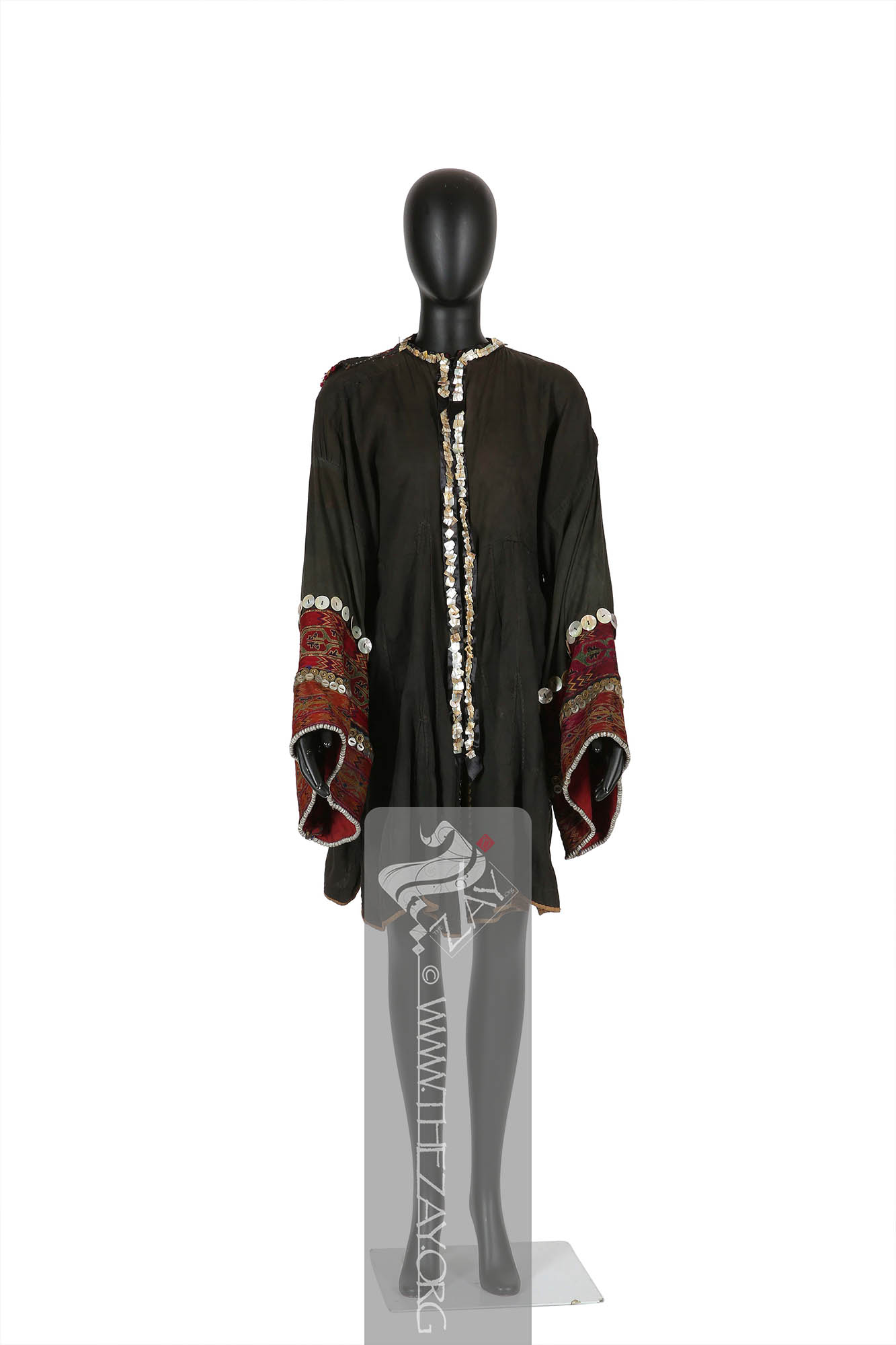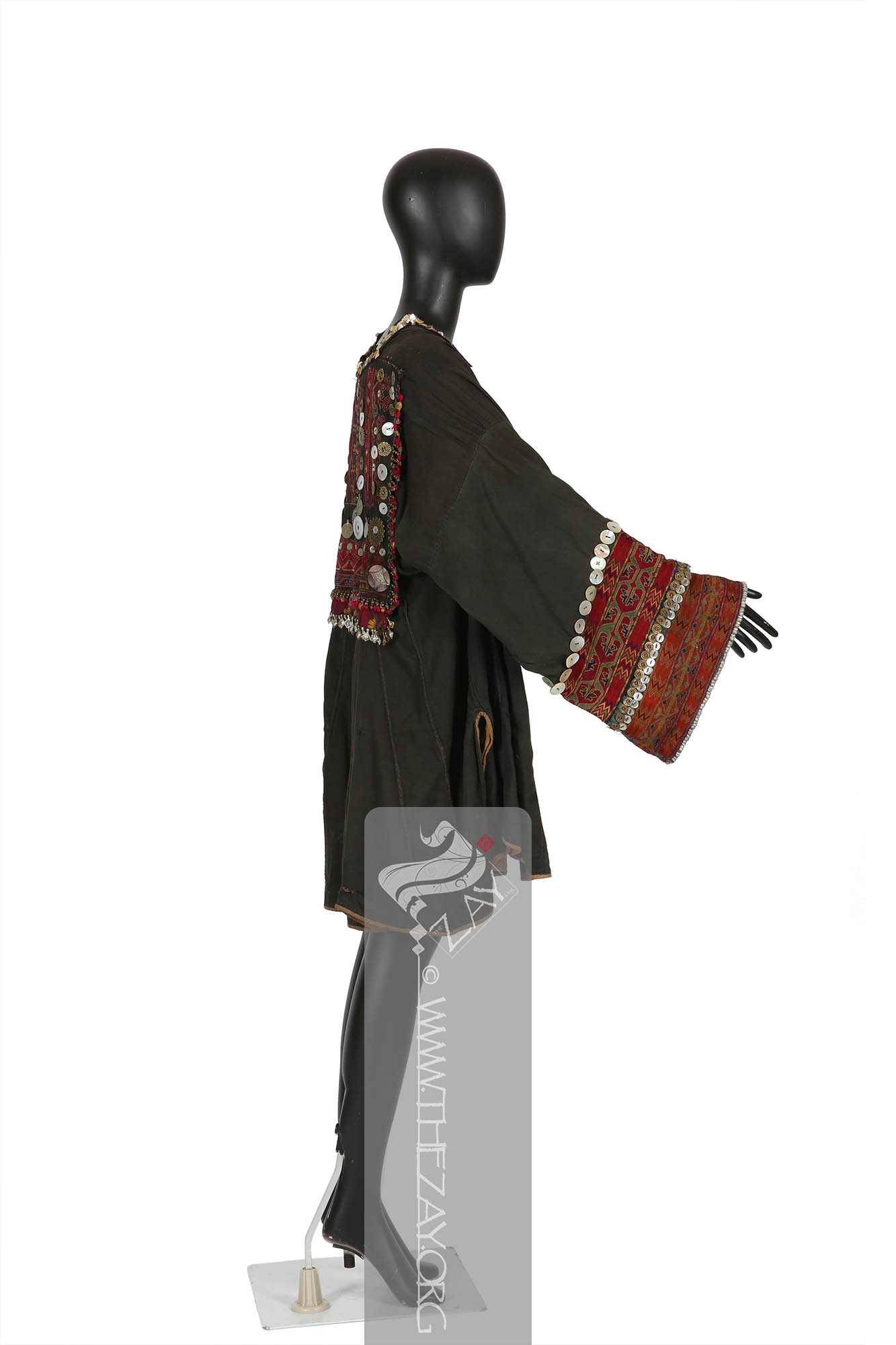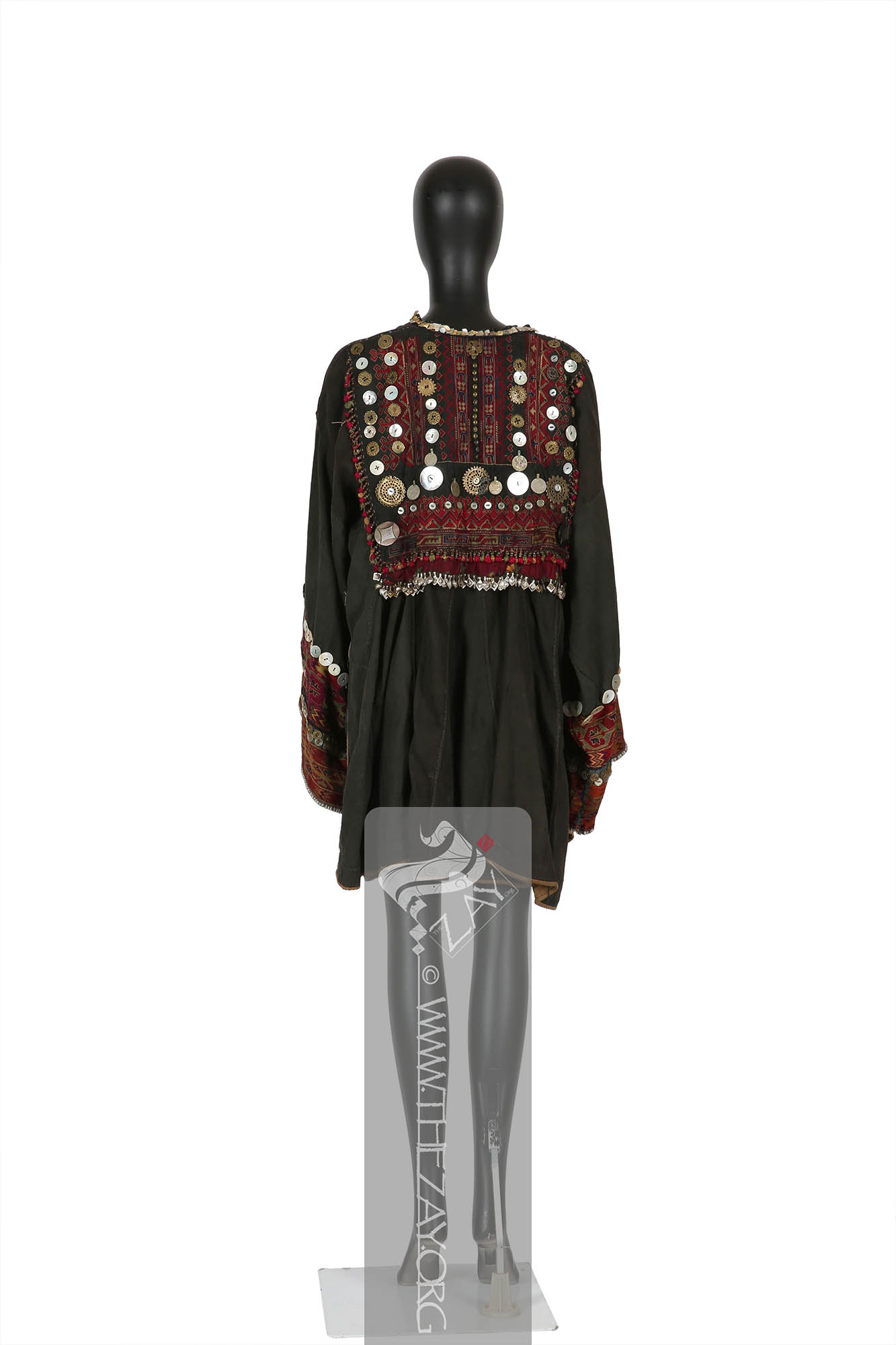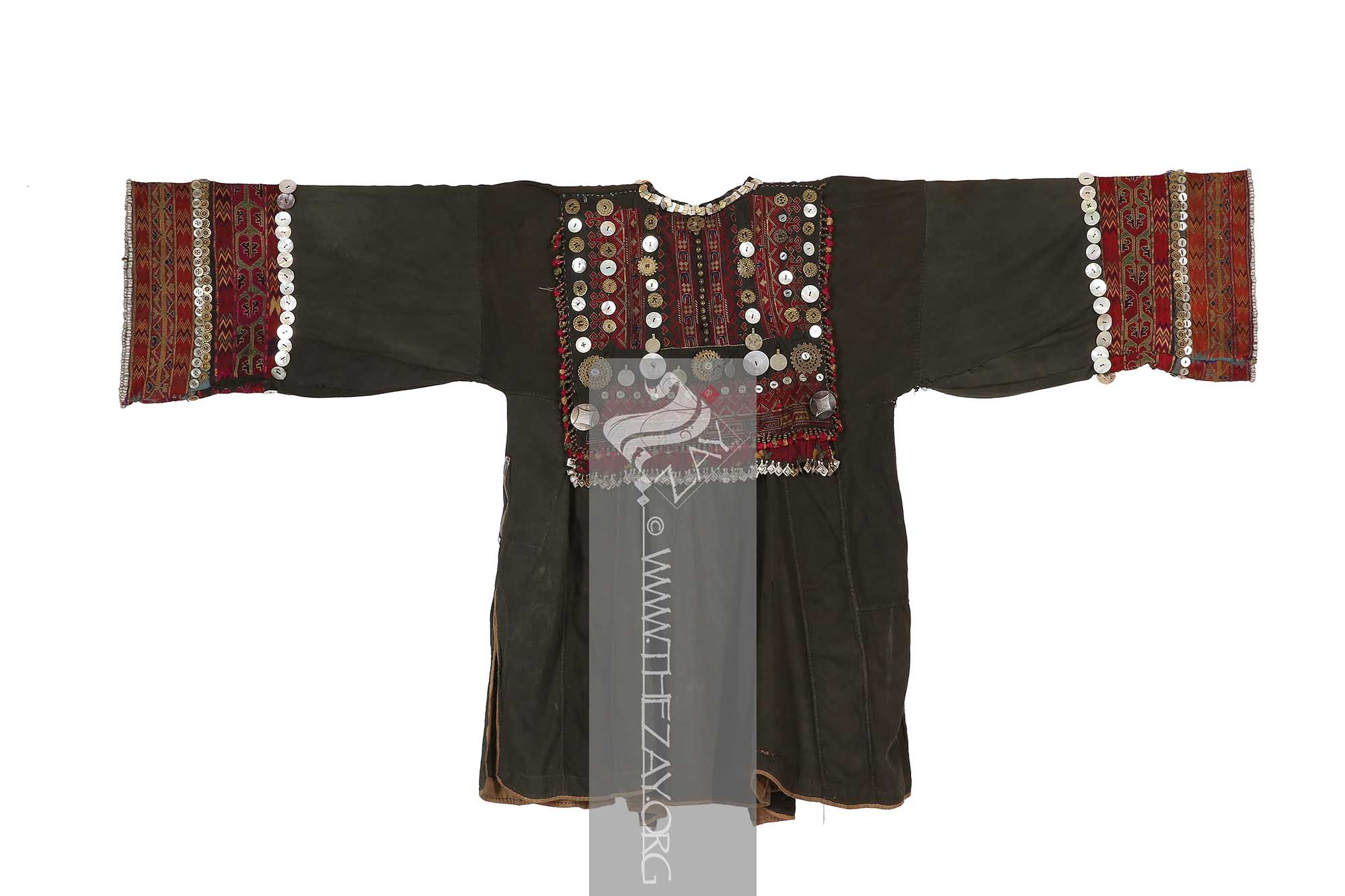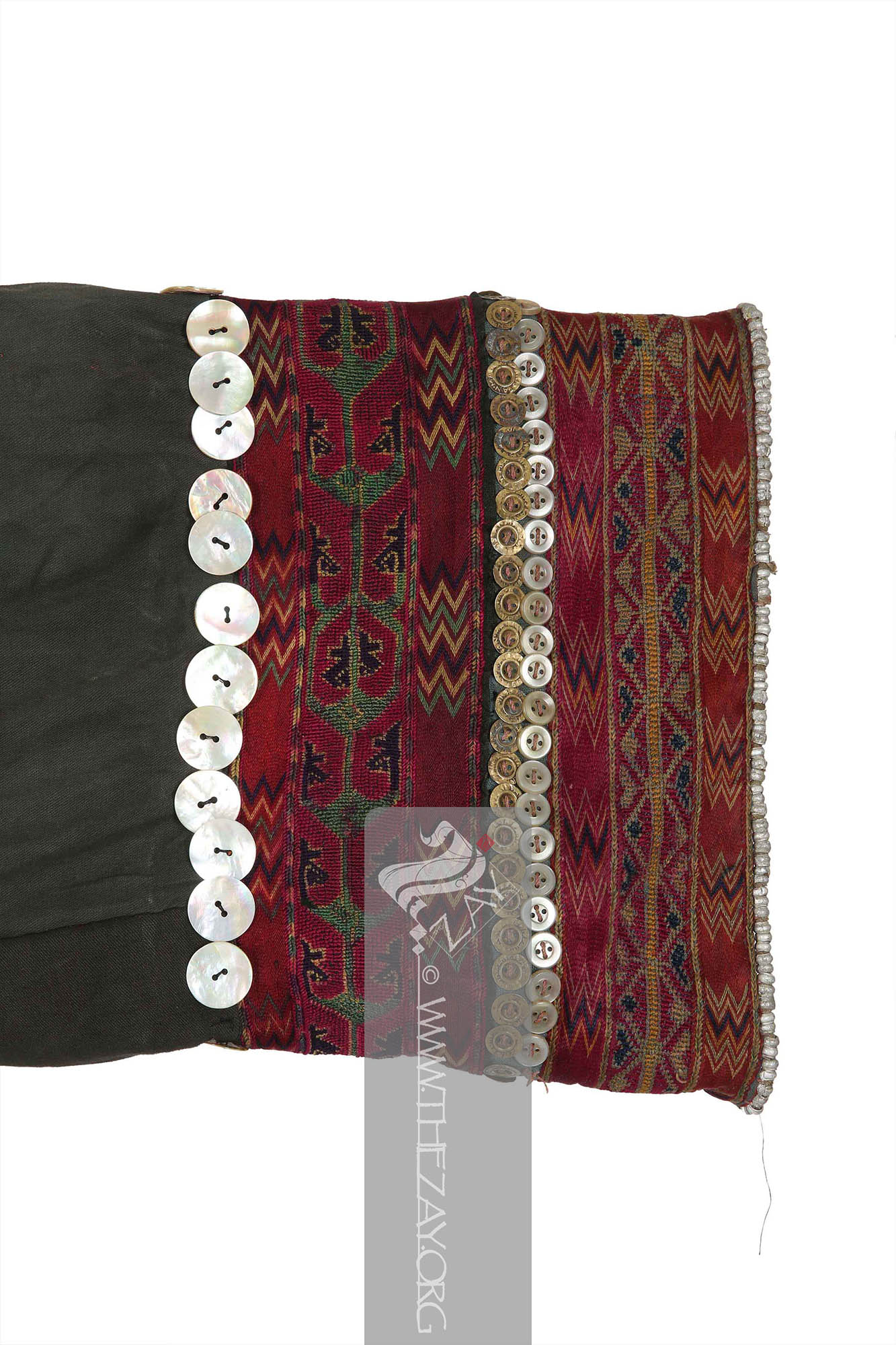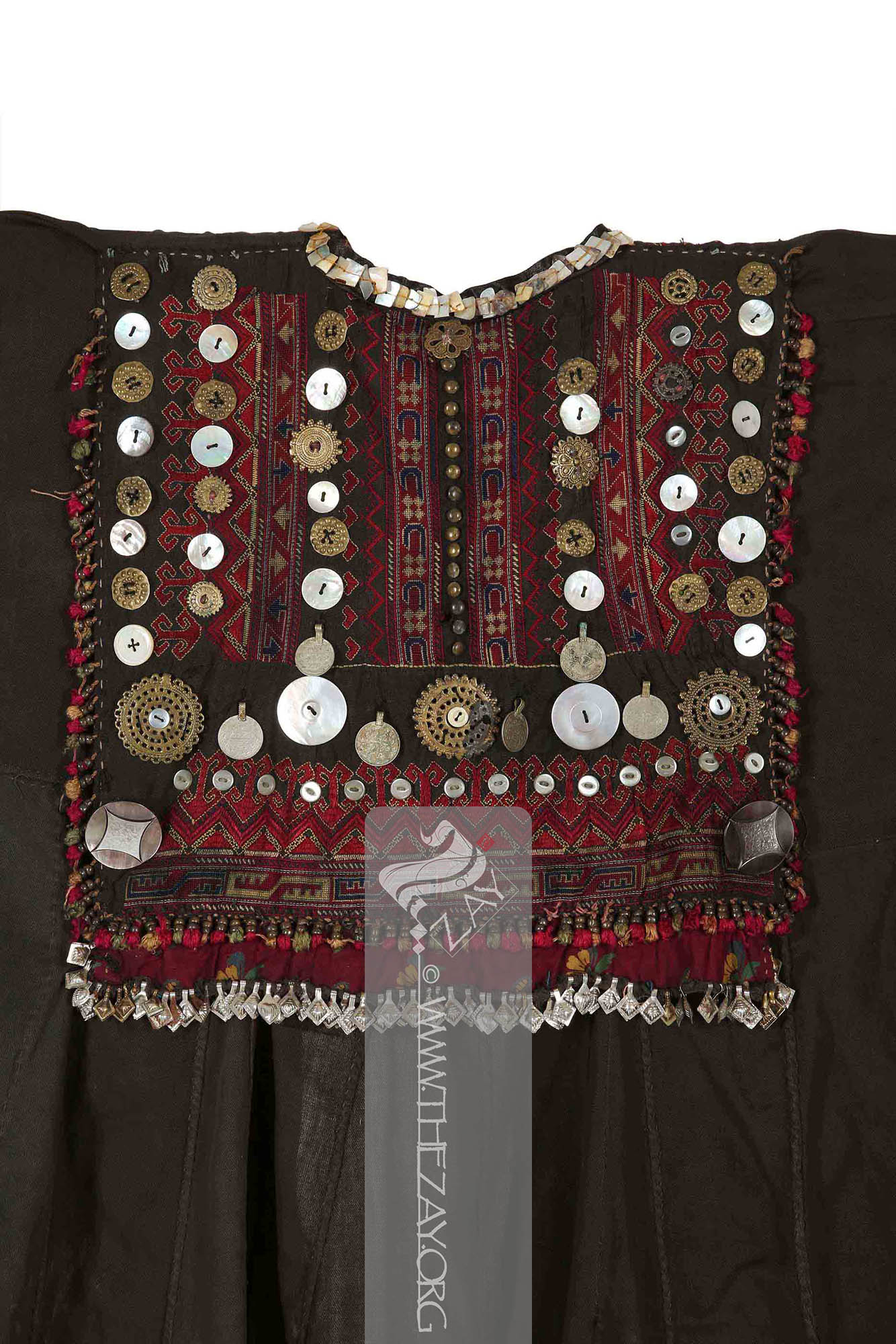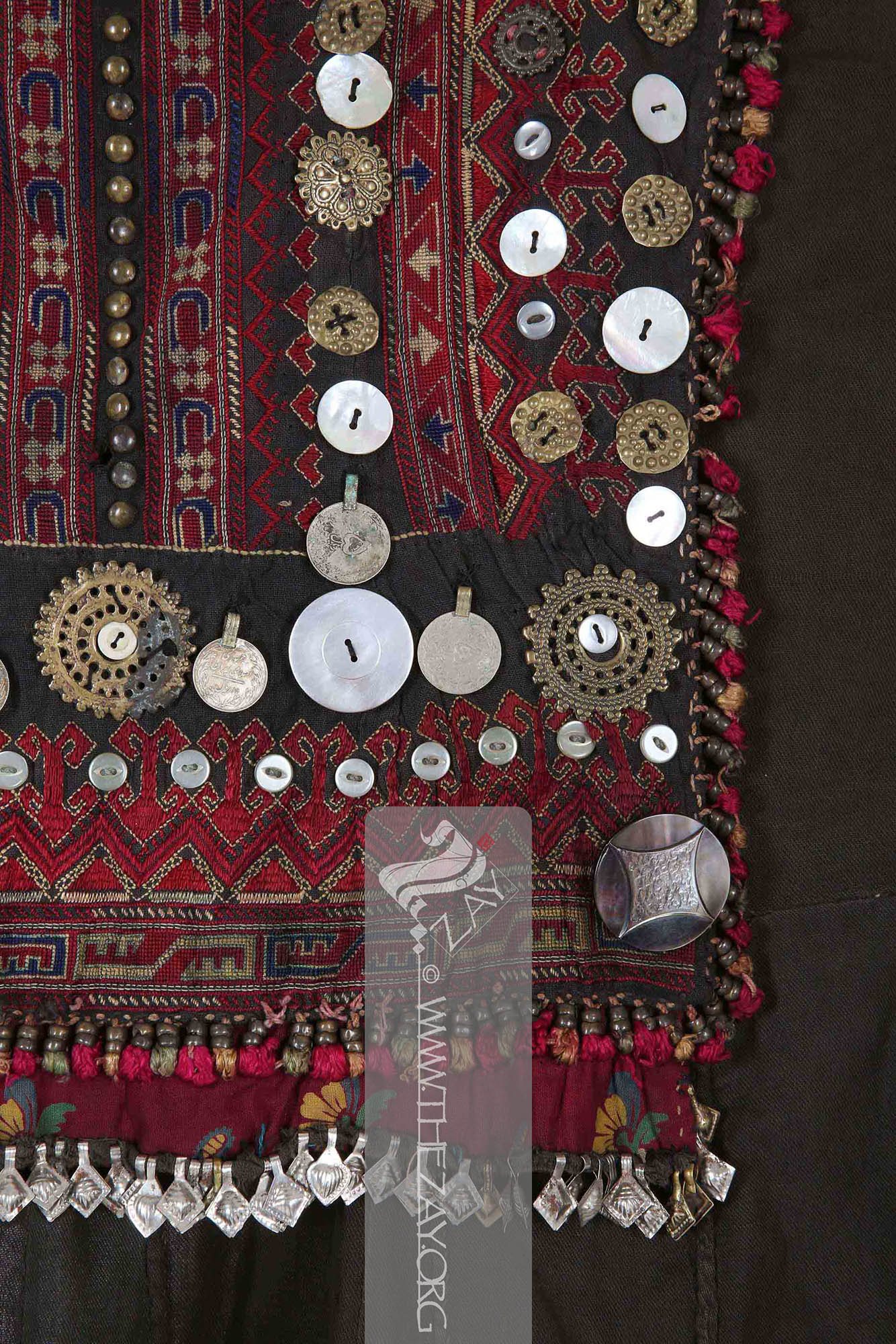Object HistoryThis beautiful brown cotton (
jumlo
Jumlo: An elaborately decorated knee length women’s traditional tunic native to the southern Central Asia and the northern Indian subcontinent. It is usually worn with a pair of trousers and an embellished shawl
Shawl: (Persian: shāl from Hindi: duśālā – Shoulder Mantle), a shawl is a South Asian version of a scarf worn or wrapped loosely over the shoulders and is usually made of wool. . ) tunic was purchased by
Dr. Reem Tariq
Ṭariq: (Arabic; Synonym: tulle_bi_talli
Tūlle_bi_tallī: (French: Tulle – a city in France where fine material for veil was first made; Turkish: tel – wire; Synonym: tariq; talli; badla; khus_dozi ), series of small metal knots made on a woven net ground as embellishment. The term is commonly used in the North African Arab region specifically in Egypt.
; talli; badla; khus_dozi ), series of small metal knots made on a woven net ground as embellishment. The term is commonly used in the Levant Arab region specifically in Lebanon.
El Mutwalli
Dr. Reem Tariq
Ṭariq: (Arabic; Synonym: tulle_bi_talli
Tūlle_bi_tallī: (French: Tulle – a city in France where fine material for veil was first made; Turkish: tel – wire; Synonym: tariq; talli; badla; khus_dozi ), series of small metal knots made on a woven net ground as embellishment. The term is commonly used in the North African Arab region specifically in Egypt.
; talli; badla; khus_dozi ), series of small metal knots made on a woven net ground as embellishment. The term is commonly used in the Levant Arab region specifically in Lebanon.
el Mutwallī: Founder (CEO) of the Zay
Zay: (Arabic: costume, Pl. azyaā’), a set of clothes in a style typical of a particular country or historical period. Initiative, a public figure, speaker and author. An expert curator and consultant in Islamic art and architecture, interior design, historic costume, and UAE heritage. at the Sharjah Islamic market (suq)– an outstanding market for antiques in the UAE – presently known as The Blue Souq, in 1996. The piece was repurposed and was used by her until eventually it was added to The
Zay
Zay: (Arabic: costume, Pl. azyaā’), a set of clothes in a style typical of a particular country or historical period. Initiative collection.
Object Features This is a beautiful black cotton tunic style repurposed jacket that was originally a women’s tunic from the tribes native to the Indus – Kohistan and Nuristan valley regions of Pakistan and Afghanistan respectively. Known as a (
jumlo
Jumlo: An elaborately decorated knee length women’s traditional tunic native to the southern Central Asia and the northern Indian subcontinent. It is usually worn with a pair of trousers and an embellished shawl
Shawl: (Persian: shāl from Hindi: duśālā – Shoulder Mantle), a shawl is a South Asian version of a scarf worn or wrapped loosely over the shoulders and is usually made of wool. . ) in the native tongue, it is constructed of thick black cotton woven in (
twill_tapestry
Twill_tapestry: a weaving technique that creates diagonal patterns on a textile surface. Oldest archaeological remains of this type of weave dates back to 3000BCE in the Turfan province of China. Its application in other ancient civilizations such as the Incas are also well recorded. ) style.
The
jumlo
Jumlo: An elaborately decorated knee length women’s traditional tunic native to the southern Central Asia and the northern Indian subcontinent. It is usually worn with a pair of trousers and an embellished shawl
Shawl: (Persian: shāl from Hindi: duśālā – Shoulder Mantle), a shawl is a South Asian version of a scarf worn or wrapped loosely over the shoulders and is usually made of wool. . originally was heavily embellished with separately woven patches hand stitched to the tunic.
These patches are flat (
kilim
Kilim: (Persian: Gilīm or galīm from Akkadian or Aramaic; Synonym: Plas), a traditional weaving technique with possible Central Asian origins. It involves tightly interlacing weft
Weft: one of the two basic components used in weaving that transforms thread or yarns into a piece of fabric. It is the crosswise thread on a loom that is passed over and under the warp threads. and warp
Warp: One of the two basic components used in weaving which transforms thread or yarns to a piece of fabric. The warp is the set of yarns stretched longitudinally in place on a loom before the weft
Weft: one of the two basic components used in weaving that transforms thread or yarns into a piece of fabric. It is the crosswise thread on a loom that is passed over and under the warp threads. is introduced during the weaving process. threads to create flat-woven geometric patterned rug and tapestry
Tapestry: wall hanging or other large piece of fabric that is woven in coloured weft
Weft: one of the two basic components used in weaving that transforms thread or yarns into a piece of fabric. It is the crosswise thread on a loom that is passed over and under the warp threads. threads or embroidered with a decorative design. Typically made of wool, but they can also be made of other materials such as silk, linen, or cotton. Often used to decorate homes, churches, and other buildings. fabrics in vibrant colours. It is widely popular across Central Asia, Iran, and Türkiye. ) style woven wool and (
cross_stitch
Cross_stitch: A popular form of embroidery in which X-shaped stitches are used to create a design on fabric. It is a simple and versatile technique that can be used to create a wide range of patterns and designs and is commonly used in decorative and functional embroidery projects.) embroidery. The sleeves are possibly silk with separately woven
kilim
Kilim: (Persian: Gilīm or galīm from Akkadian or Aramaic; Synonym: Plas), a traditional weaving technique with possible Central Asian origins. It involves tightly interlacing weft
Weft: one of the two basic components used in weaving that transforms thread or yarns into a piece of fabric. It is the crosswise thread on a loom that is passed over and under the warp threads. and warp
Warp: One of the two basic components used in weaving which transforms thread or yarns to a piece of fabric. The warp is the set of yarns stretched longitudinally in place on a loom before the weft
Weft: one of the two basic components used in weaving that transforms thread or yarns into a piece of fabric. It is the crosswise thread on a loom that is passed over and under the warp threads. is introduced during the weaving process. threads to create flat-woven geometric patterned rug and tapestry
Tapestry: wall hanging or other large piece of fabric that is woven in coloured weft
Weft: one of the two basic components used in weaving that transforms thread or yarns into a piece of fabric. It is the crosswise thread on a loom that is passed over and under the warp threads. threads or embroidered with a decorative design. Typically made of wool, but they can also be made of other materials such as silk, linen, or cotton. Often used to decorate homes, churches, and other buildings. fabrics in vibrant colours. It is widely popular across Central Asia, Iran, and Türkiye. style cuffs in burgundy, green, yellow, and blue. A heavily embellished rectangular patch is hand stitched on what used to be the front of the tunic.
The patch is embroidered and embellished with brass as well as plastic buttons, as well as other metal press stud buttons, metal beads possibly silver and brass, a metallic zip, considerably new strips of
satin
Sātin: (Arabic: Zaytuni: from Chinese port of Zayton in Quanzhou province where it was exported from and acquired by Arab merchants), one of the three basic types of woven fabric with a glossy top surface and a dull back. Originated in China and was fundamentally woven in silk. ribbons with mother-of-pearl chips, and coins or riyal from the Islamic Republic of Iran – probably a much later addition to the garment since the coins came into effect post-1979 Iranian Revolution.
The tunic has a full skirt constructed of multiple triangular panels that are hand stitched together and attached to the (
bodice
Bodice: (English: body), or bodices the plural form of body, it is the close-fitting garment meant to cover the body above the waist or the torso. However, it was not until the 17th century that the term became synonymous to women’s undergarment. ).
The
jumlo
Jumlo: An elaborately decorated knee length women’s traditional tunic native to the southern Central Asia and the northern Indian subcontinent. It is usually worn with a pair of trousers and an embellished shawl
Shawl: (Persian: shāl from Hindi: duśālā – Shoulder Mantle), a shawl is a South Asian version of a scarf worn or wrapped loosely over the shoulders and is usually made of wool. . tunic is traditionally worn with a pair of trousers or (
salwar
Salwar: (Farsi: shalvār; Synonym: ṣarwāl, shirwāl ), trousers featuring tapering ankles and drawstring closure of Central Asian origin. They disseminated in the Indian subcontinent between c.1st-3rd century BCE. Although exact period of its arrival in the Arab world is disputed their widespread adoption is confirmed from the 12th century.
) and an equally lavishly embellished (
shawl
Shawl: (Persian: shāl from Hindi: duśālā – Shoulder Mantle), a shawl is a South Asian version of a scarf worn or wrapped loosely over the shoulders and is usually made of wool. ) by tribal women in the region panning the Swat Valley, Khyber Pakhtunkhwa province, Indus – Kohistan Valley, Nuristan Valley, and a degree the Kashmir valley of the Indian subcontinent.
Unfortunately, the tunic was repurposed into a jacket by cutting the back of the tunic to form a jacket-like opening and wearing the original front on the back.
Links 



